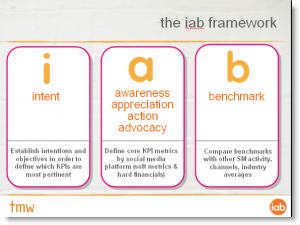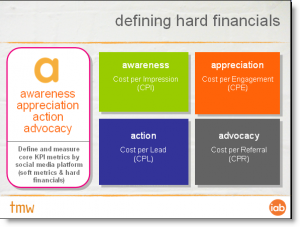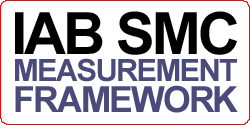One of the biggest ‘hot potatoes’ right now is how to measure social media activity and whether it’s possible to apportion ROI. It seems every man, woman and dog has an opinion on the matter!
And for good reason.
The days of whimsical experimentation have long gone. Nowadays, marketers have to justify every budget line with robust KPIs, solid business cases or definitive break-even/ ROI analysis. Not so easy when it comes to evaluating that ‘fluffy social media stuff’ but if we genuinely want this to be taken seriously it’s imperative we start making it much more accountable.
More accountability, more standardisation
But for this to happen there really needs to be a degree of standardisation across the industry so that we’re all talking the same language (or at least singing from the same ‘karaoke machine’!) But the truth is there’s currently too much inconsistency in the industry to draw any salient or meaningful conclusions. As it stands, it’s almost impossible to benchmark our respective activity as everyone is measuring performance differently. This is compounded by the fact that social media is so versatile, diverse, complex and multi-faceted, spanning many disparate objectives and many different platforms - no wonder we’ve struggled to find a common methodology which works across everything.
A step in the right direction
What I’m about to share with you may not address all these challenges but will hopefully move us in the right direction. TMW have been working in close consultation with the IAB Social Media Council to develop a new measurement framework to help practitioners evaluate their social media activity more effectively and consistently. It’s not rocket science. In fact, it’s a very simple framework, designed to be flexible enough to be applied across a broad spectrum of social media platforms, whilst at the same time giving practitioners the freedom to use their own experience and expertise to choose the most appropriate KPIs.
Rather serendipitously, the measurement framework we’re proposing shares the same acronym as the Internet Advertising Bureau, so at least it’s dead easy to remember!

You can view the full presentation of this approach below.
The presentation talks through each step of the process from establishing up front your intent, assigning the most pertinent KPIs according to the 4 As – Awareness, Apprecitation, Action and Advocacy – and consulting other benchmarks in order to draw meaningful comparisons.
There’s an array of KPIs which one can assign to each of these 4 As. As a starter for ten we’ve provided a selection to choose from but this list is not exhaustive by any means. Which KPIs you choose to apply will fundamentally vary according to the intent you define, the platform you’re using, the tracking you have in place and the internal expectations of various stakeholders and whether they demand hard financials as well as soft metrics.
Defining some hard financials
Ultimately, I believe we all need to be working towards some hard financials which over time will become established as industry standards. I’ve deliberately steered away from ROI per se – that’s a debate for another day – but instead would favour the four financial KPIs in line with the 4 As (see table below). How we calculate these KPIs is still to be defined but the principle of having one or more of this hard financials to evaluate or benchmark our activity could be extremely beneficial in my view.

Feedback welcome
The Council plans to officially promote this framework to the wider industry in a couple of weeks, but it would be great to get some feedback to ensure this is a collaborative effort. What we’ve outlined may not suit everybody but we believe it’s a step in the right direction and would encourage as many practitioners as possible to adopt it where they can. The more aligned the industry becomes, the more accountable social media will become and the easier it will be for all of us to digest the complexities of social media measurement.
Surely that’s something worth striving for?
by , senior marketing manager, Skive
It is an important part of Skive’s business to partner with agencies that we admire and who have complimentary skillsets. We regularly go into the agencies to present new work we are doing but also our observations on digital marketing. I was recently asked to give a presentation on “The Future of Digital” to the brand teams at a large PR agency.
I started off by asking how many people in the room are on twitter. About 80% said that they were and a fair proportion of them said they use it regularly, at least once a day. I then asked them how many of them were on it a year ago and the number was greatly reduced. The point is this shows how quickly technology changes and that as digital marketers we need to stay ahead of the game. The purpose of this blog post is to look at what is the future of digital and what we might expect from it in the near future.
First off we’ll start off with a quick reality check. Twitter is great right? I mean it’s everywhere, you can’t move for it. I think this is very true if you work in marketing and you spend all day plugged in to tweetdeck for the latest Social Media tidbit from Mashable or other. I’m not dumbing down its importance to those interested in the realtime web but none of my friends outside of work are on it. Let’s put it another way. Farmville has over 80 million active users that are more than the number total twitter users. When did you last suggest to a client that they try and leverage Farmville as a viable social platform?
 Read more…
Read more…
By , Skive and , TMW
Here’s some thoughts on the biggest challenge with the content user-generated space, and a couple of things we can do about them, complete with UGC checklist. Let us know what you think!
Mark runs us through the process of how brands traditionally targeted their consumers before the days of digital. He talks about how social media can drive this consumer identification method for brands in a easier more precise way through the art of conversation.
, digital social media director at Markettiers4DC, discusses how best to use broadcast within social media and how interactive video can add to your social activity. He talks about the most effective online methods when seeding content and once it’s out there, the best ways to get your consumers to interact with it. Russell also quashes the myth that all B2B brands are dull and therefore produce less interesting work, providing some great case studies along the way.





